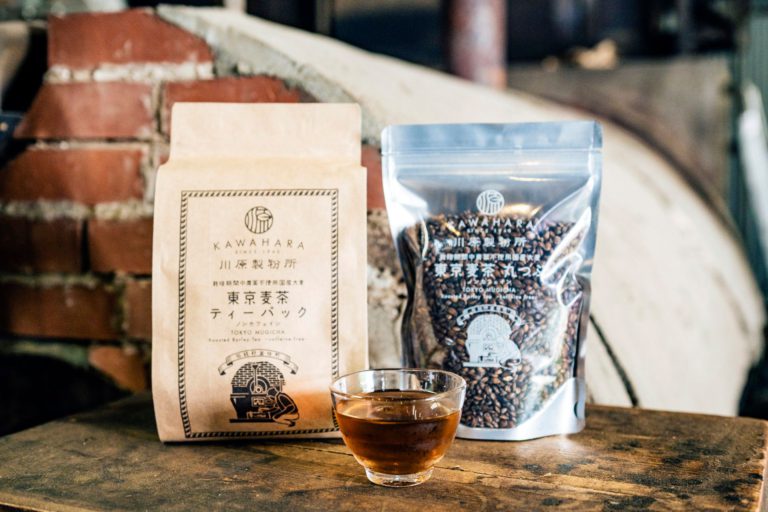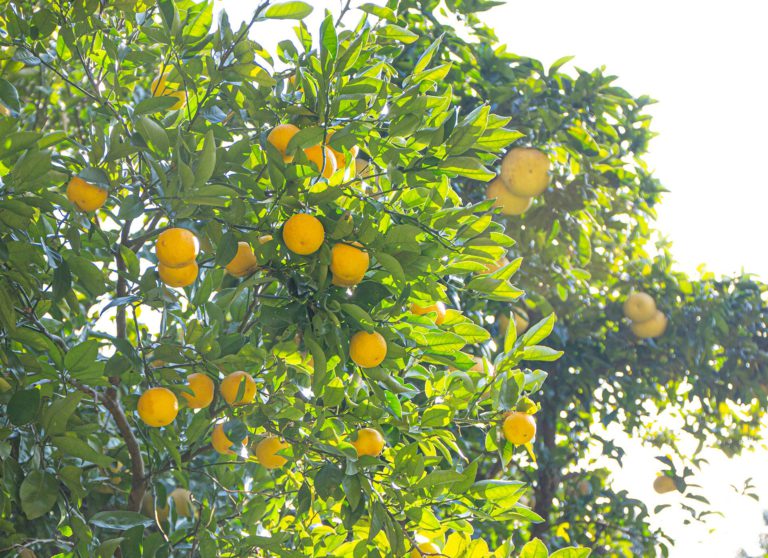Inheriting the Rich Food Culture of the Marketplace
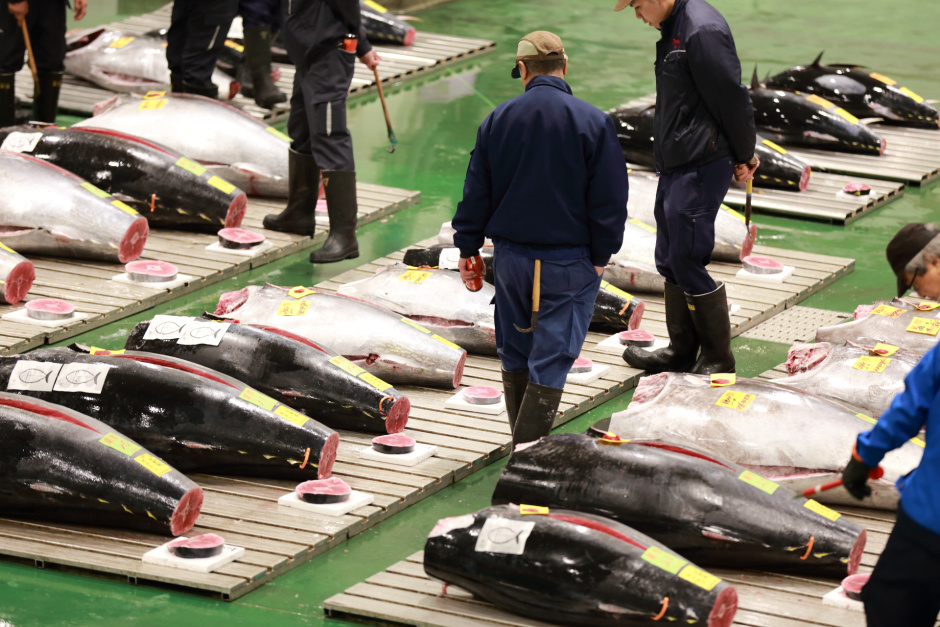
Establishing a cold chain has boosted seafood quality
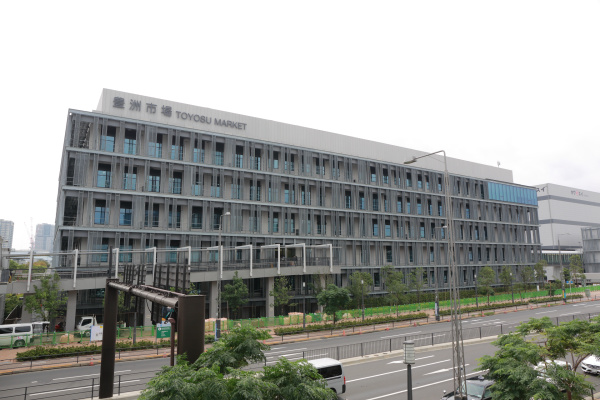
We saw a sprawl of low-rise buildings after getting off at the Yurikamome Shijo-mae Station. The Toyosu Market is located on a site with a slightly futuristic urban atmosphere which area is 40 hectares. It is a closed-type facility that allows fresh produce to be stored at more optimal temperatures than before. “Ensuring Food Safety and Security” is the most distinctive feature of the Toyosu Market.
“The closed environment allows for much better hygiene management,” say workers in the market. As the former Tsukiji Market only had a few walls, allowing outside air to enter the facility, temperatures within the market exceeded 30℃ at times during the summer. However, now in Toyosu, the temperature is maintained at approximately 10℃ all year round.
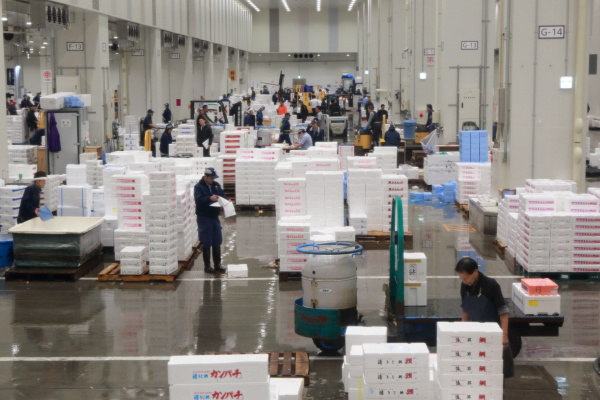
“It’s like working inside a refrigerator, so now we always wear long-sleeved jackets. It’s a harsh environment to work in, but there is no doubt that the fish quality is excellent,” laughs an auctioneer. The fish in this market are of world-class quality—making the Toyosu Market a facility that supports the food culture of Japan, which is something to be proud of.
The walls and floor within the market connect in a curved shape. This is a design that prevents unwanted grime from accumulating. Furthermore, shutter curtains to keep the cold air in, air curtains to prevent dust and insects from entering, and hand-washing facilities have also been installed throughout the market in order to maintain a high level of hygiene management.
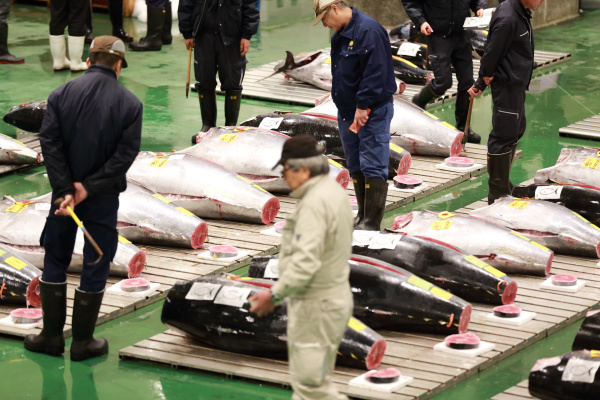
The Fisheries Wholesale Market Building features an observation route and a reservation-only observation deck, enabling both hygiene management and the promotion of sightseeing. There are no longer limitations to the number of visitors at the observation route, so visitors can watch ongoing auctions at their convenience. Reservations made a month in advance are necessary for the observation deck, where visitors can experience exciting auctions right before their eyes. There are approximately 1,000 tuna auctioned in the market every day. Auctions start from 5:30 a.m. and the tuna disappears from the auction room in a few hours. On the day we visited the market for this report, the observation facilities were busy from early in the morning, with many overseas visitors there to watch the auctions.
Roles of the unique market system of Japan
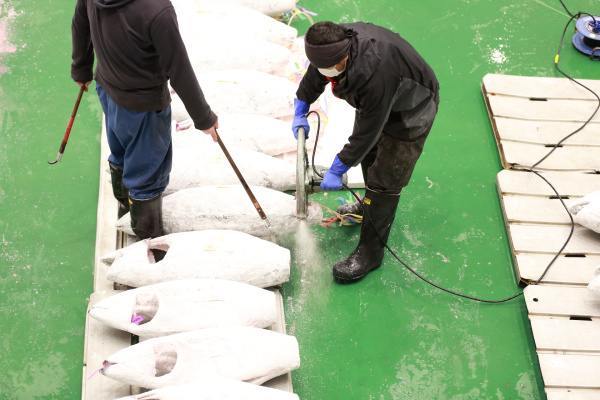
Around 4:00 a.m., before the auctions start, wholesalers (sellers) go around slicing pieces of tuna tailfins of the fish lined up for auction. Once all the tuna has been gathered, intermediate wholesalers (buyers) start to assess the fish. They prepare for auctioning by checking the physique and sliced tailfin cross-section to see the color and fattiness of the fish. The intermediate wholesalers take their job very seriously, as they need to procure fish that meet their clients’ requirements, which may be fish stalls or chefs.
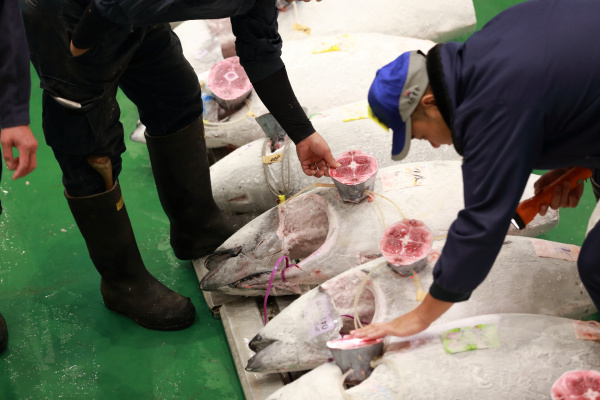
This assessment activity is also one aspect that has not changed with the move from Tsukiji to Toyosu.
For instance, it is common to cook fish in many foreign countries, so there is hardly any need to focus on the quality of the fishes’ flesh. Just weighing is enough for these types of fish. The diverse culture of raw food in Japan, which many Japanese take for granted, is supported by this type of central wholesale system.
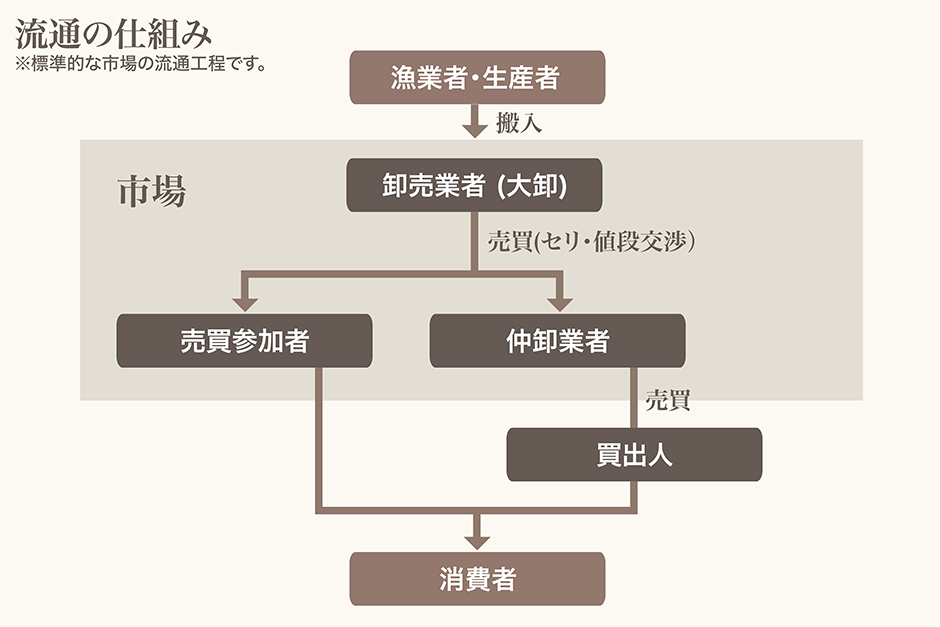
The system of wholesalers, who are experts on production areas (fishing grounds), and intermediate wholesalers, with their skillful selection of fish, is unique to Japan.
Everyone at the market recognizes that their professional obligations need to be fulfilled, whether they be fishermen, wholesalers or businesses that distribute produce and restaurants. It could be said that the reason Japan has diverse food ingredients circulating in an intricate system that maintains quality and stable prices, is the market “mechanism” and the “people” who support this system.
Even if the location of markets changes, the colorful food culture of Japan has been, and will always continue to be handed down person to person. It is inherited by people and supported by people. We rediscovered this sentiment with our visit to the Toyosu Market.
Professional profiles inherited from the Tsukiji Market
The Japanese food culture is handed down from each person to person. We visited some workers in the Toyosu Market to elaborate on this sentiment.
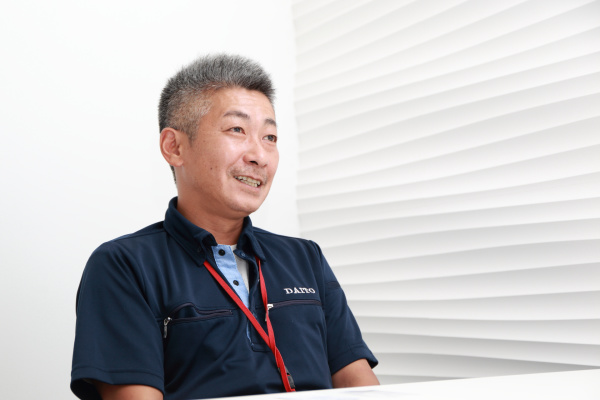
Safeguarding the fish-eating culture, which is the core of Japanese food
[Wholesaler] Takahiro Ikuta (auctioneer) of the Daito Gyorui First Tuna Division, Tuna Department
Daito Gyorui bears one corner of the world’s largest seafood product transactions. The Tuna Department handles 300 to 500 wild and farmed tuna a day, mainly through auctions, from major domestic production areas as well as Australia, Mexico and various European countries.
A license is necessary to become an auctioneer at tuna auctions, which is the main event of wholesale markets. Ikuta had three years of experience in the field and passed tests to become a qualified connoisseur for fresh tuna. His base is Hokkaido, where his family has been engaged in the fishing business ever since his grandfather’s generation. Ikuta yearned to work at the Tsukiji Market, setting him on his current path.
“It is important to look at many fish to become an auctioneer. The shape, freshness and fattiness change according to the season. One only can gain experience by observing the fish that come in every day,” says Ikuta.
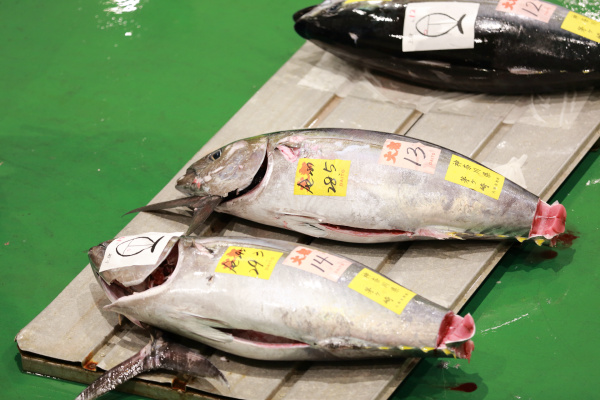
By the way, auctioneers are contracted to sell produce from fishermen (producers/shipowners), and auctioneers call fishermen “owner of goods.”
Ikuta explains, “Our motto is to stand in the shoes of the owner of goods and take responsibility for fair and just transactions.”
After auctions end, auctioneers make their way to intermediate wholesalers’ shops to ask about the quality of the fish. Another important role an auctioneer has is to see the fish to the end and deliver feedback to the owner of goods.
“Markets are very public and need people to keep them alive. All we can do is protect the fish-eating culture with pride and continue on in the same way as the Tsukiji Market,” says Ikuta regarding his work.
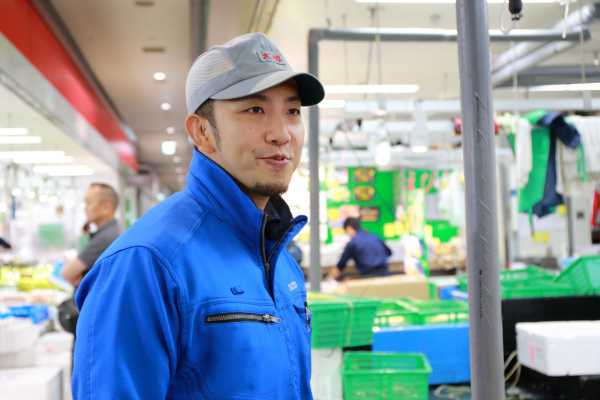
There will always be jobs for connoisseurs
[Wholesaler] Takenori Harada of the Daito Gyorui High-grade Fish Division, High-grade Fish Department
The Special Fish Department of Daito Gyorui handles top-quality fresh fish for high-end establishments such as Japanese restaurants and sushi restaurants. Harada has handled crab products all by himself since his second year in the company.
In the beginning, he had no knowledge of his work, and “went to every major landing harbor in Hokkaido to learn about crab types and production areas from producers,” says Harada.
He arrives at the auction site at 2:30 a.m. every morning. As 80% of crabs are preordered, Harada checks the quality and confirms orders. He finishes selling by 5:00 a.m., including additional orders, prepares for the following day’s deliveries and completes his deskwork between 7:00 and 8:00 a.m. This is a typical day at work for Harada.
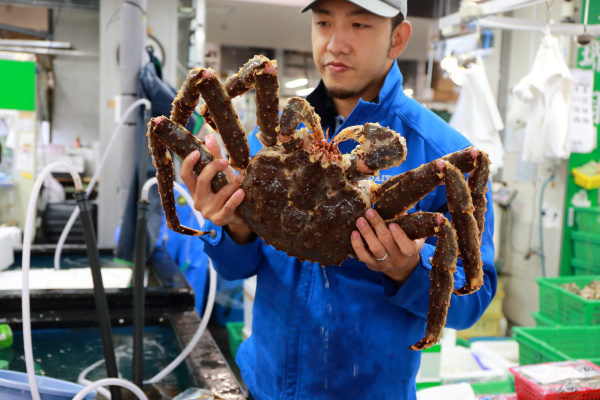
As crabs are luxury ingredients, clients demand a high standard for crabs, such as lively, fresh crabs, well-shaped and packed with meat, and crabs that have a beautiful color when boiled. Furthermore, “Crabs do not sell during hot seasons, but we tend to be very busy at New Year’s. The fluctuation between seasons is intense, and the price swings are also large, making it hard work. I’ve been so focused on my work, I once dreamed about being chased by crabs!” laughs Harada. He now has memorized the market price for crabs, doing away with extreme price fluctuations.
“Daily purchases are predicated on estimates three to four days in advance, such as predicting that less people will eat out due to a World Cup match, or predicting more people eating crab as the Nikkei Average goes up. It is strategy based on information.”
He says that relationships among people is also important to wholesalers.
“I make sure to build relationships of trust, so that others will want to purchase from me. Being a ‘connoisseur’ is especially important in this industry of specialty seafood. I am sure that this job will continue to be relevant, as long as we focus on our dedication toward being professionals.”
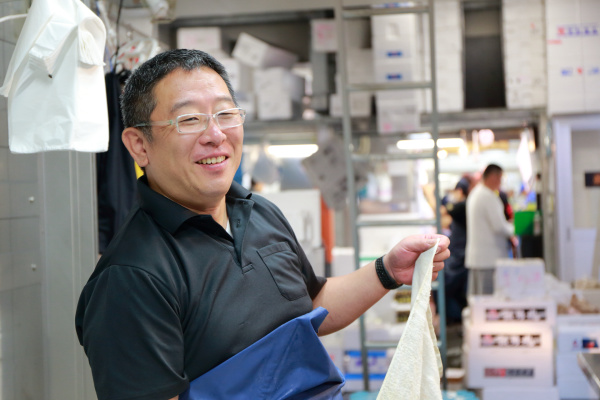
Eating fish more casually by offering dietary education at local classes
[Intermediate wholesaler] Masuo Ogawa, President and Representative Director of Takatoku
Ogawa is a company president with an unusual resume. He quit his job as a salesperson at a financial company and became an intermediate wholesaler, founding Takatoku in 2006. At the transfer of the market from Tsukiji to Toyosu, Takatoku launched four stores, which include specialty stores for frozen tuna and fresh fish stalls, establishing a unique form of business as well.
“Before the move, clients in Nihombashi and Ginza were saying that it would be too far for them to come to us at Toyosu. So, we created a delivery system to take our products to them.”
He states that recently many orders are being made via email and online shops.
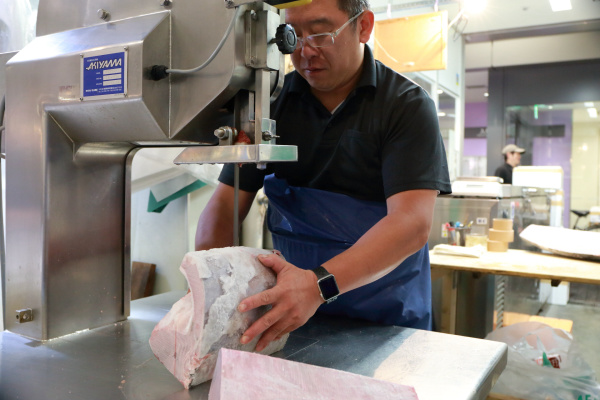
Ogawa has a sense of impending danger toward the fact that fish is not consumed at general households. Because of this, he launched a fish cooking class that offers dietary education. This class is mostly run by his wife, with classes at public facilities and gyms in Chuo-ku, which has turned out to be popular among young mothers who are local residents.
“The town of Toyosu has really changed these past few years. Market workers are often invited to community-development events, so we have been making efforts to participate in neighborhood events or to collaborate with local chefs.”
His goal is to become an intermediate wholesale market loved by locals.
“The reason we use IT is to enable face-to-face communication for customer relations in our spare time. The government created a wonderful receptacle, which is the Toyosu Market. Ever since the move to Toyosu, everyone working at the market now must step up and figure out ‘how to create great content for Toyosu,’” explains Ogawa.
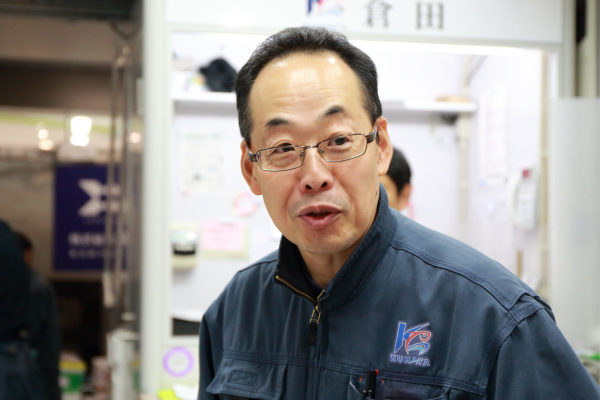
Launching a processing factory to create a new Toyosu brand
[Intermediate wholesaler] Toshiyuki Kurata, Representative Director of Kurata Shoten
“One positive aspect of the move to Toyosu is how the market functions have improved dramatically. It has provided us enough momentum to actively focus on fish processing operations,” says Kurata.
Due to the issues in temperature zones within Tsukiji Market, active operations and sales never came to fruition. However, the move to Toyosu has cleared hygiene management standards, allowing the company to expand into fish filleting, fine bone-picking and dried produce. Currently the company ships out fillets, three-piece filleted fish, cut open fish and fish pieces to hospitals, nursery kitchens, food truck businesses and restaurants, offering high-quality Toyosu fish according to customer needs.
“The lead time for fresh fish, from purchase to sales, is too short to communicate information to customers and correspond to various needs. Daily left-over fish will contribute to food loss as well. However, fish processing will allow us to proactively use quality fish that did not meet standards and are not suitable for fresh fish. For instance, the fish and chips we sold at a Saturday market were prepared using uneven-sized fish that did not meet standards. The fish were processed into bite-sized or finger-cut pieces, making it easier to carry around at the event. The fish and chips were a great hit!” says Kurata.
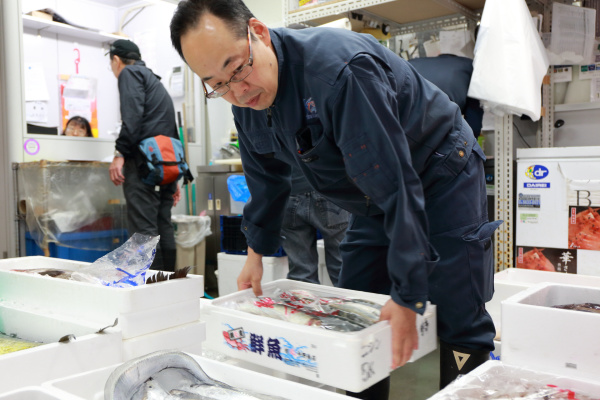
Additionally, the company has partnered with a food delivery company and is scheduled to start selling fish for meal kits and hot pot sets this fall. Kurata’s policy is “We do what others don’t, in our own way,” which has allowed the company to expand outside of the intermediate wholesale category.
“We want to fully apply the benefits gained with this move to Toyosu. We are currently developing products such as our company’s unique dried fish, fish pieces, and pickled fish that can be easily cooked with a frypan at home or sold in food trucks. There are about to be many changes within the environment, in which regulations have been relaxed through the Wholesale Market Law reform. We want to increase our value in society while acting as a bridge between production areas and consumers.”
The people working in the market have been flexibly adapting to the needs of society and the times, while polishing skills and continuing to seek new areas of success. The fish culture of Japan will continue to develop if the passion of these professionals who aim to “deliver delicious fish to consumers” is handed down to future generations.

